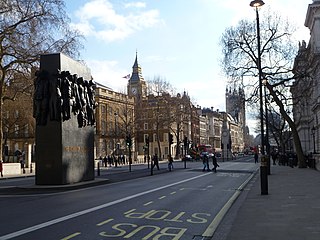
Whitehall is a road and area in the City of Westminster, Central London, England. The road forms the first part of the A3212 road from Trafalgar Square to Chelsea. It is the main thoroughfare running south from Trafalgar Square towards Parliament Square. The street is recognised as the centre of the Government of the United Kingdom and is lined with numerous departments and ministries, including the Ministry of Defence, Horse Guards and the Cabinet Office. Consequently, the name "Whitehall" is used as a metonym for the British civil service and government, and as the geographic name for the surrounding area.

Field Marshal Alan Francis Brooke, 1st Viscount Alanbrooke,, was a senior officer of the British Army. He was Chief of the Imperial General Staff (CIGS), the professional head of the British Army, during the Second World War, and was promoted to field marshal on 1 January 1944. As chairman of the Chiefs of Staff Committee, Brooke was the foremost military advisor to Prime Minister Winston Churchill, and had the role of co-ordinator of the British military efforts in the Allies' victory in 1945. After retiring from the British Army, he served as Lord High Constable of England during the Coronation of Queen Elizabeth II in 1953. His war diaries attracted attention for their criticism of Churchill and for Brooke's forthright views on other leading figures of the war.

Viscount Alanbrooke, of Brookeborough in the County of Fermanagh, was a title in the Peerage of the United Kingdom.
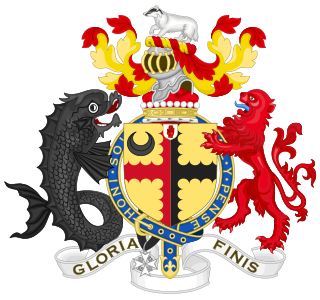
Viscount Brookeborough, of Colebrooke in the County of Fermanagh, is a title in the Peerage of the United Kingdom. It was created in 1952 for the Ulster Unionist politician and Prime Minister of Northern Ireland, Captain The Rt. Hon. Sir Basil Brooke, 5th Bt., P.C. (N.I.), M.P.

Horse Guards Parade is a large parade ground off Whitehall in central London. It is the site of the annual ceremonies of Trooping the Colour, which commemorates the monarch's official birthday, and the Beating Retreat.

Henry Hardinge, 1st Viscount Hardinge, was a British Army officer and politician. After serving in the Peninsular War and the Waterloo Campaign he became Secretary at War in Wellington's ministry. After a tour as Chief Secretary for Ireland in 1830 he became Secretary at War again in Sir Robert Peel's cabinet. He went on to be Governor-General of India at the time of the First Anglo-Sikh War and then Commander-in-Chief of the Forces during the Crimean War.

Field Marshal Hugh Gough, 1st Viscount Gough, was a senior British Army officer. After serving as a junior officer at the seizure of the Cape of Good Hope during the French Revolutionary Wars, Gough commanded the 2nd Battalion of the 87th Regiment of Foot during the Peninsular War. After serving as commander-in-chief of the British forces in China during the First Opium War, he became Commander-in-Chief, India and led the British forces in action against the Marathas defeating them decisively at the conclusion of the Gwalior campaign and then commanded the troops that defeated the Sikhs during both the First Anglo-Sikh War and the Second Anglo-Sikh War.
This is a list of people who served as Lord Lieutenant of Monmouthshire. Before the English Civil War, the lieutenancy of Monmouthshire was held by the Lord Lieutenant of Wales, except for the period from 1602 to 1629, when it formed a separate lieutenancy in conjunction with Glamorgan. After the English Restoration in 1660, it was again held by the Lord Lieutenant of Wales from 1672 until 1694, when the twelve central Welsh lieutenancies were divided. After 1715 each office holder was also Custos Rotulorum of Monmouthshire. The combined position was finally abolished on 31 March 1974 and replaced with that of the Lord Lieutenant of Gwent.
This is a list of people who formerly served as Lord Lieutenant of the County of London.
Thomas Brooke, 2nd Viscount Alanbrooke was a British peer. He was the son of Field Marshal Alan Brooke, 1st Viscount Alanbrooke.

Alan Henry Brooke, 3rd Viscount Brookeborough, is a Northern Irish peer and landowner. He is one of the 92 hereditary peers who remain in the House of Lords; he sits as a crossbencher. He is the current Lord Lieutenant of Fermanagh.
Events from the year 1749 in Great Britain.
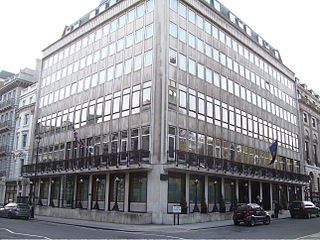
The Army and Navy Club in London is a private members' club founded in 1837, also known informally as The Rag.
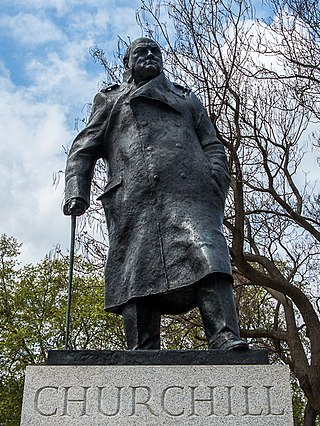
Ivor Roberts-Jones was an English sculptor of Welsh descent on both his parents' sides. He is best known for his sculpted heads of notable people such as Yehudi Menuhin and George Thomas, Viscount Tonypandy.

The statue of Winston Churchill in Parliament Square, London, is a bronze sculpture of the former British prime minister Winston Churchill, created by Ivor Roberts-Jones.
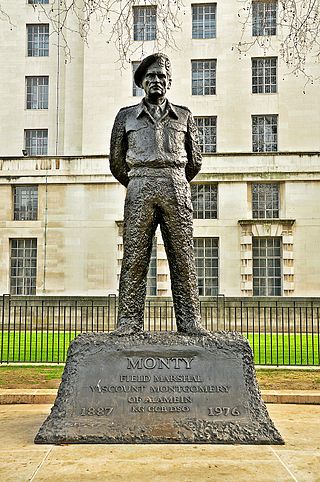
The statue of Bernard Montgomery, 1st Viscount Montgomery of Alamein is located outside the Ministry of Defence Main Building in Whitehall, London, United Kingdom. It was designed by Oscar Nemon and stands alongside statues of William Slim, 1st Viscount Slim and Alan Brooke, 1st Viscount Alanbrooke.

The equestrian statue of Prince George, Duke of Cambridge is a life-size memorial by Adrian Jones, installed in Whitehall, London, England.

The statue of William Slim, 1st Viscount Slim in Whitehall, London, is a work of 1988–1993 by the sculptor Ivor Roberts-Jones. It is one of three memorials to British military leaders of World War II on Raleigh Green, outside the Ministry of Defence's Main Building, the others being Oscar Nemon's 1980 statue of Lord Montgomery and Roberts-Jones's statue of Lord Alanbrooke, erected later in 1993. Slim's bronze statue stands approximately 3 metres (9.8 ft) high on a pedestal of Portland stone.














